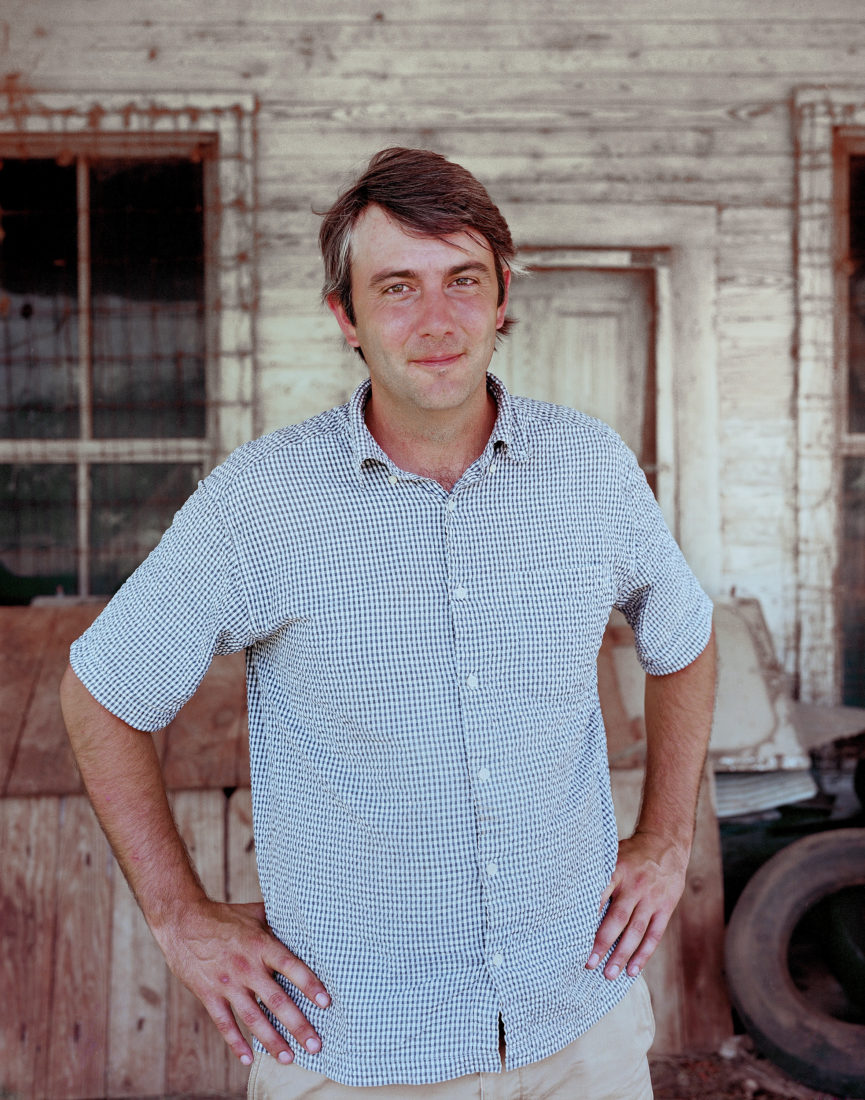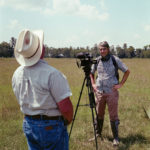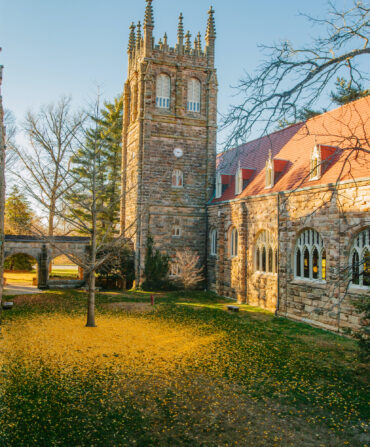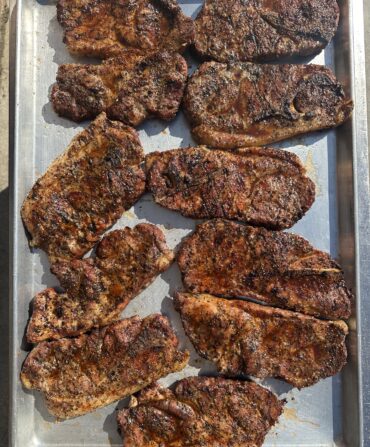A zydeco song, heavy on the fiddle, plays in the station wagon. “Hog-killing music,” Joe York says as we race past the flat, green fields of Avoyelles Parish in Louisiana. He tails a blue pickup driven by a man who looks like a Cajun Johnny Cash and calls himself a “coonass cowboy.” We are headed to a boucherie—a pig butchering—and York wants everything on film. He lifts a camera onto the dashboard and steadies it with his hands, leaving the steering to his forearms.
“Do you want me to hold the camera?” I ask, eyeing the curves ahead.
York looks amused.
“No, this is how it gets done,” he says. “This is how it gets done when you’re not here.”
A filmmaker at the University of Mississippi, York works frequently with the Southern Foodways Alliance. A nonprofit’s budget means no sound or lighting crew, nobody holding a big fuzzy microphone. Just York and his modest equipment, which helps explain the intimacy and honesty in his films about the South’s food and people. Two weeks ago, he followed Allan Benton, the renowned bacon maker, around a Tennessee mountain in search of ramps. Now he’s in bayou country. In little more than a year, York has driven forty thousand miles across nine Southern states.
He does it for stories like this one. The man in black, Gerald Lemoine, parks his truck beside a low-slung metal building. We follow him through a cabinet workshop and out the back, emerging in sunlight and a soft, humidity-cutting breeze. What York is about to film is increasingly rare. Cajuns in this area once held regular boucheries. Neighbors gathered to share work and meat, to make cracklings from the pig’s skin and red boudin from its blood. The boucherie’s decline explains why gas stations and markets usually sell white boudin: Fresh blood is scarce. A proper boucherie takes hours. It requires men capable of hoisting a two-hundred-pound animal, lifting it onto tables, lowering it into tubs. “My kids kinda got a phobia of all this because what I’d do is get them up at three o’clock in the morning and we’d be standing around the fire when it’s cold, killing pigs,” Lemoine says. “And I’d hear them talking under their breath: ‘When that old bastard dies, we ain’t gonna be doing this stuff.’”

Photo: Hollis Bennett
Hard at work at White Oak Pastures in Bluffton, Georgia.
The Workingman’s Filmmaker
York grew up in Glencoe, Alabama, the son of a steelworker and a schoolteacher. He does not consider himself a documentary filmmaker–too artistic-sounding–but circumstances usually force him to identify as such. “I associate way more with the people we’re documenting than with other people who make films,” York says. “It feels very blue-collar. It’s about going to work and editing and getting the job done.”
By all accounts, York, a thirty-four-year-old with wisps of gray hair, works as hard as a man on a factory line. He might spend eight weekends on the road, returning to sit on the couch every evening and edit footage on a laptop while his girlfriend reads a book. Since 2003, he has made more than thirty short films about Southern food, as well as a feature-length documentary, Saving Willie Mae’s Scotch House, about the reconstruction of a New Orleans restaurant following Hurricane Katrina. He has chronicled cattle farmers and oystermen and squirrel hunters, African American tamale makers and Vietnamese fishermen. In addition, York made Mississippi Innocence, a feature about two men wrongly convicted of murdering little girls in Noxubee County. His talent for humanizing his subjects served the film well, and by the time he finished, York had befriended the two exonerees. He is now working on a feature about Southern food in all its regional variations–from beef barbecue in Texas to wild honey in Florida.
“He’s more prolific than maybe anybody I’ve ever met,” says Micah Ginn, who worked with York at the University of Mississippi’s Media and Documentary Projects Center. “He loves storytelling, and he loves for viewers to experience the story just the way he experiences the story.”
A York film, Ginn notes, is recognizable by its lack of York. He doesn’t appear on camera; viewers don’t usually hear his voice. He leaves the storytelling to images, and to the men and women he interviews, which helps him avoid lazy stereotypes about the South. York often describes his work as being in opposition to fast-and-flashy shows that traffic in taste alone, as in “This is not going to be the Food Network version of Louisiana.” He hopes to make people hungry, sure. But he also wants viewers to fall for the culture and place behind the fried chicken or the smoked pork. Along the way, he tends to dismantle the idea that urban elites invented slow food and small farms.
Filmmaker Les Blank, the master chronicler of Americana, says he knows of no other documentarian making comparable movies. “There’s a warmth for people, for what they’re doing,” Blank says. He mentions Smokes & Ears, York’s short about the duo of pig ear sandwiches and hot smoked sausage sandwiches served at the Big Apple Inn in Jackson, Mississippi. “The people who go in there to eat them, they love eating that stuff,” Blank says. “They have special meaning for them, and he’s able to show this.”

Photo: Hollis Bennett
Foodie Flick
Joe York breaks for lunch.
To get the right shots, York has put his cameras in barbecue pits. He has hung them off the sides of speedboats. He has returned cameras to the office caked in mud. “He would get back, we’d watch some of the footage, and our boss, Andy Harper, would be like ‘Holy smokes,’” Ginn says. “He’d say, ‘Great shot, but don’t ever do that again.’”
From the start, York pursued filmmaking with single-minded determination. He went to Oxford as a graduate student in the Southern Studies program, after working on archaeological digs in the South and in Mexico. The department had no track for aspiring documentarians, so he hounded Harper and John T. Edge, the director of the Southern Foodways Alliance, until they helped him make movies. “Joe saw himself as a filmmaker before he ever pushed record,” Harper says.
Of Pigs and Blood
York squats on a wooden table with his camera, inches from the snout end of the pig carcass. A pair of farmhands flank the pig, and Lemoine stands on the ground opposite York, having just eased a tangle of intestines from the abdominal cavity.
Getting to this point has taken some effort. Earlier, the farmhands had dropped the pig into a vat of 148-degree water to loosen the hair, then used their hands and knives to rub its body clean. After removing the innards, Lemoine cuts off the pig’s head with a hacksaw and hangs it on a winch. The familiar delicacies—ribs, belly, hams, chops—come into focus. “Now, in Louisiana French, they call that reintier,” Lemoine says, pointing. “That means backbone.”
When the butchering is done, the cuts get hung to drain any excess blood. Then Lemoine and his farmhands walk into the kitchen to make red boudin. First, they boil liver, kidneys, heart, and a few small cuts of meat. “Boudin was actually made from the trash meat,” Lemoine says. “You added the rice so it went further.” Once cooked, the organ meat goes into a grinder. Next, Lemoine adds salt, pepper, blood, and rice. He tastes the raw mixture for seasoning. “The blood is what gives it the flavor, the texture—everything,” he says.
York doesn’t like to think that the people he gets close to belong to a disappearing culture. He’d rather joke about his job than self-aggrandize: “If I could just get a sponsorship from Prevacid and Tide, then we could really make some movies.” But his travels have forced him to acknowledge that the South has entered a transition period. “We’re at this point where people are either going to keep doing this–whatever the world thinks–or they’re not,” he says.
We’ve been here for more than five hours. York has had his camera positioned near Lemoine’s head for much of that time. “I’ll get this thing out of your face for a while,” York says.
“Yeah, that’s kind of hard to get used to right up close. You could shoot a little farther? It would do a little bit better, you know.”
“That’s where I like to be, though.”
“Oh, you like to be up close?”
“Yes. It’s better that way.”









